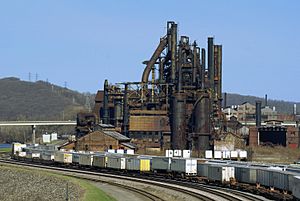History of the steel industry (1970–present) facts for kids
The global steel industry has changed a lot since 1970. Countries like China and India have become huge producers and users of steel. In Europe, many steel companies have joined together. Making steel uses a lot of energy and creates a lot of carbon dioxide (CO2), which is a gas that contributes to climate change. In fact, the steel industry causes about 7% of the world's energy use and a big part of global CO2 pollution. Did you know that Singapore is a main place where iron is traded around the world?
Contents
How the Steel Industry Grew
Steel production grew a lot during the 20th century. At the start of the 1900s, only 28 million tonnes of steel were made each year. By the end of the century, this number jumped to 781 million tonnes! In the United States, people used the most steel per person in 1977. After that, the amount they used went down by half before slowly going up a bit again.
World Steel Production in the 20th Century

The amount of raw steel made has grown incredibly fast. By 2017, the world produced 1.691 billion tonnes of steel.
During the 1900s, the amount of steel used each year grew by about 3.3%. In 1900, the United States made 37% of all the world's steel. But after World War II, countries in Asia started making more steel. China especially invested a lot. By 2017, China alone made 50% of the world's steel. Europe (including the former Soviet Union) made 24%, and North America made only 6%.
You can find more details about how much steel each country produces at steel production by country.
Future Growth of Steel Production
Many other countries are also making more steel. In 2017, South Korea produced 71 million tonnes, which is almost twice as much as Germany. Brazil made 34 million tonnes. These three countries haven't changed much since 2011.
India's steel production in 2017 was just over 100 million tonnes. This is a big jump from 70 million tonnes in 2011. When India became independent in 1947, it only made 1 million tonnes of steel. By 1991, when its economy opened up, steel production grew to about 14 million tonnes. After that, it doubled in the next 10 years. It is now doubling again, but over a slightly longer time.
The world steel industry slowed down from 2007 to 2009, staying at 1,300 million tonnes. This was because of a worldwide economic slowdown that started in 2008. This slowdown meant less building was happening, so people needed less steel. Prices for steel also dropped by 40%.
For example, in 2007, a company called ThyssenKrupp spent $12 billion to build two very modern steel factories in Alabama and Brazil. But they lost $11 billion on these new plants because they had to sell steel for less than it cost to make. In 2013, the plants were sold for less than $4 billion.
Today, the steel industry is looking for new ways to make steel. This is because the usual way of making steel creates a lot of CO2. Using blast furnaces and basic oxygen furnaces makes about 1.8 tonnes of CO2 for every tonne of steel. To help reach climate goals, like those in the Paris Agreement and the European Green Deal, the steel industry needs to change. They might use technology to capture and store CO2. Or they might use different ways to make steel, like electric arc furnaces. Other ideas include using plants, plastic waste, or hydrogen instead of coal in the blast furnace.
Fewer Workers in Steel Plants
Modern steel factories need fewer people to make the same amount of steel compared to the past. For example, in South Korea, a company called Posco employs 29,648 people to make 28 million tonnes of steel.
Between 1974 and 1999, the steel industry greatly reduced the number of jobs around the world. In the US, jobs went from 521,000 down to 153,000. In Japan, they dropped from 459,000 to 208,000. Germany saw a drop from 232,000 to 78,000. The UK went from 197,000 to just 31,000. Brazil's jobs fell from 118,000 to 59,000, and South Africa's from 100,000 to 54,000. South Korea already had a low number of workers, with only 58,000 in 1999. Overall, the steel industry cut more than 1,500,000 jobs worldwide in 25 years.
See also
- American Iron and Steel Institute
- British Steel Corporation
- Dominion Steel and Coal Corporation, in Canada
- European Coal and Steel Community
- Iron and steel industry in India
- Iron and steel industry in the United States
- Steel production by country
- Steel industry in China
- Steelmaking

